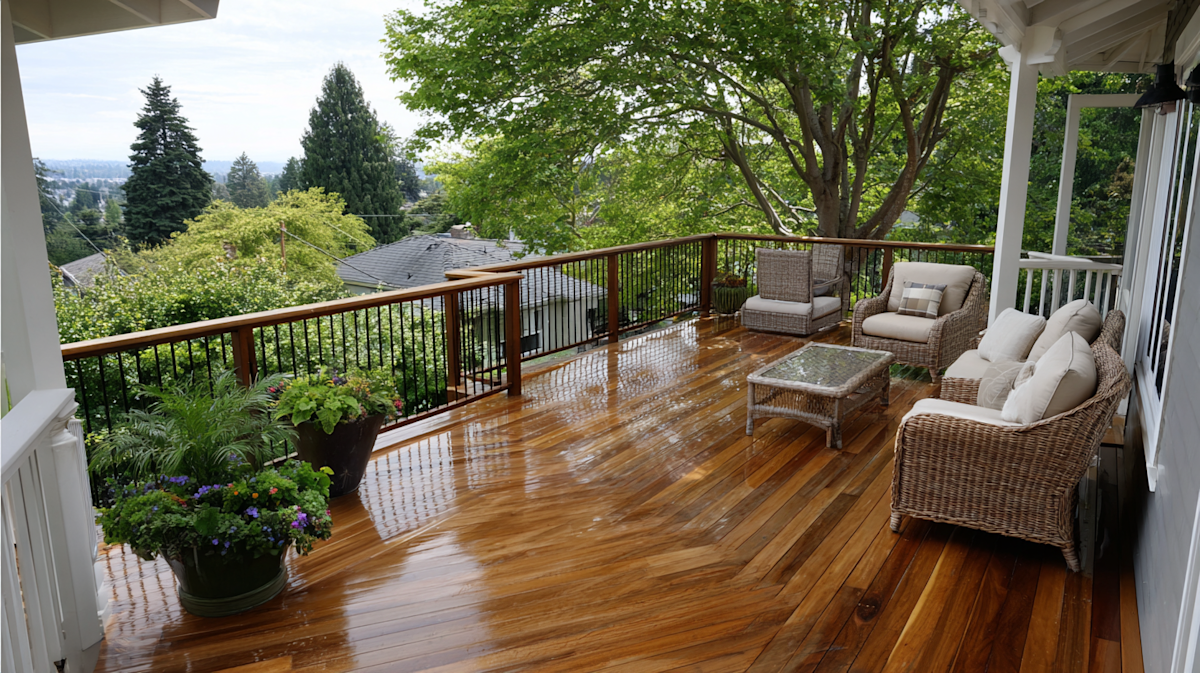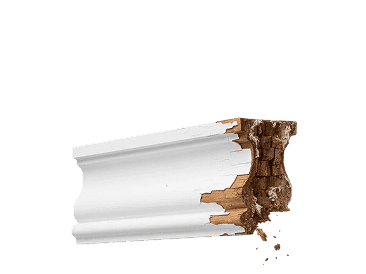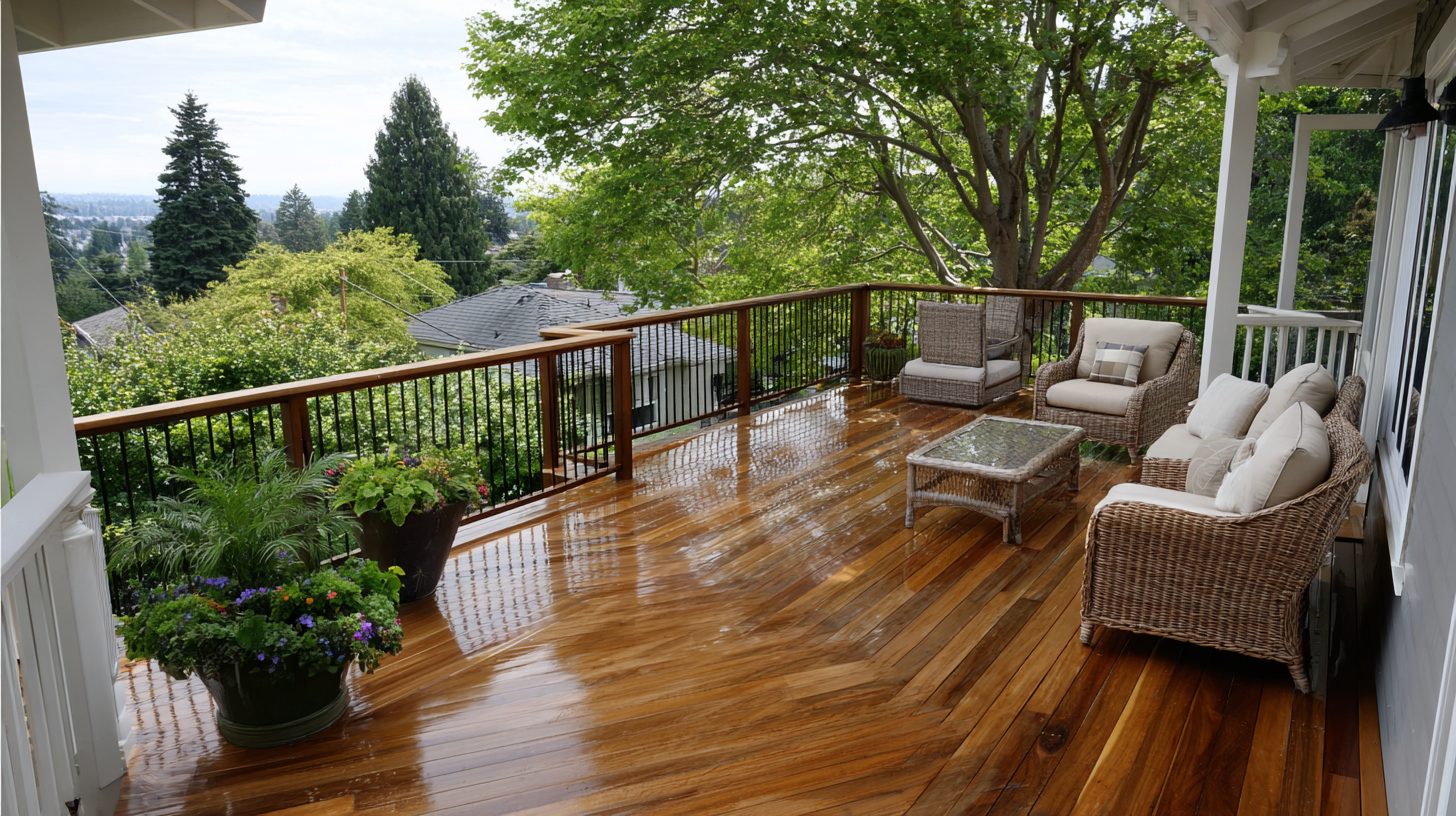Seattle Deck Repair
Experience reliable Deck Repair services in Seattle, WA with GotRot. We ensure your deck's longevity, improving safety and aesthetics. Trust us to restore your outdoor oasis.
Experience serving Seattle homeowners.
Projects completed with 5-star satisfaction.
Get a FREE assessment & estimate from our experts. No obligation, good for 30 days.

Trusted by Homeowners
Decks We've Brought Back to Life
Seattle homeowners are no strangers to dry rot and the structural damage it can do to a home’s foundation. Dry rot can affect a multitude of areas of your home, from interior wooden structures to exterior add-ons like front porches and backyard decks.
Tap images to enlarge
Seattle's Premier Deck Repair Contractors
Welcome to the leading deck repair service in Seattle, Washington! We are experts in the field, equipped with the skills, knowledge, and experience necessary to repair and maintain a vast array of deck styles, making us the top-rated company for all your deck repair needs.
Top-Rated Deck Repair in Seattle, Washington
As experienced Seattle deck repair specialists, we know that a well-maintained deck can give your home a unique aesthetic appeal. However, decks are often exposed to harsh weather conditions, making them susceptible to damage. A well-maintained deck is not only aesthetically pleasing but also safe. Here, we prioritize safety, durability, and design when providing our top-rated deck repair services. We leverage years of experience, advanced techniques, and best-quality materials for every project, ensuring you receive unparalleled repair service in Seattle.
Leading Deck Repair Services We Offer
Our deck repair services are vast and varied. Here is what we offer to Seattle residents:
- Deck Board Replacement: This involves carefully checking for rotten or damaged boards, removing them, and replacing them with new ones matching the existing design.
- Handrail Repair: We ensure safety by repairing or replacing damaged or loose handrails.
- Staining and Sealing: This process protects your deck from water damage and UV rays.
- Structural Repairs: We address deeper issues impacting the structural integrity of your deck, such as posts, beams, or joists issues.
Local Deck Repair Experts in Seattle
As local deck repair experts in Seattle, we understand the Pacific Northwest weather challenges your decks face. We have a proven track record of restoring decks to their former glory while enhancing their durability and aesthetic appeal. Our commitment has helped us establish a strong relationship with local customers, making us their first choice for deck repair.
Custom Deck Repair Solutions
Every deck repair project is unique, and we work tirelessly to offer our customers the best custom solutions. Our team conducts thorough inspections to understand the true condition of your deck before recommending the best course of action.
Why Choose Our Deck Repair Company
There are numerous reasons to choose our deck repair service:
- Expertise: We have a deep understanding and knowledge of deck repairs.
- Quality Materials: We use high-quality, durable materials to ensure long-term results.
- Professional Staff: Our team of experts is competent, passionate, and committed to excellence.
- Services Guarantee: We stand behind our work, providing a solid service guarantee to our customers.
Commitment as a Deck Repair Contractor in Seattle
Our commitment to you, as one of Seattle’s leading deck repair contractors, is to offer exceptional repair services that exceed your expectations. We strive to provide premier service, focusing on high-quality workmanship, safety, and customer satisfaction.
Don't let a damaged deck reduce your property's value or compromise your safety and enjoyment. As the top-rated deck repair company in Seattle, we look forward to restoring your deck to its best condition. Contact us today for incredible service in Washington State.
Types of Deck Repair Services
Regardless of the type, decks are exposed to a myriad of threats in their lifetime, including harsh weather conditions, insects, wood rot, and simple wear and tear. This leads to common problems like loose boards, peeling paint, wood decay, and even structural damage. Each of these issues necessitates different types of deck repair, all aimed at restoring your deck to its former glory.
Board Replacement
Board replacement is one of the most common deck repair services. Over time, deck boards may become loose, warp, crack, or even rot. This not only compromises the aesthetics of your deck but also poses safety risks. Our experienced team will assess the situation, extract the old boards, and replace them with new ones, ensuring your deck’s functionality and aesthetics are maintained.
Re-Staining and Sealing
If your deck isn't properly sealed or its finish is worn, the wood is susceptible to water damage and rough weather. This is where re-staining and sealing comes in. This involves cleaning the wood, then applying a stain to restore color and safeguarding the wood with a sealant. The result is a deck that radiates warmth and resilience.
Railing Repairs
Deck railings, especially wooden ones, are prone to wear and tear due to exposure to elements. If you have loose, weakened, or damaged railings, railing repair services are necessary. We take care of spindles, balusters, posts, handrails to ensure they are secure and appealing.
Structural Repair
In severe situations, parts of the decking structures like joists, stairs, or even the substructure could be compromised. Structural deck repairs are more complex, involving the replacement or reinforcement of these critical elements to ensure the deck’s stability and safety.
Deck Refinishing
Decks can lose their appeal due to discoloration, chips, scratches, or dullness caused by use and exposure. Deck refinishing usually involves thorough cleaning, sanding, staining, and sometimes painting, offering your deck a fresh and appealing look.
Pest Damage Repairs
Insects like termites and carpenter ants can cause significant damage to your wooden deck. Pest damage repair involves removing the infestation and repairing the affected areas. This typically involves replacement or fortification of affected boards, posts, or joists.
Post Replacement
Over time, deck posts can weaken or rot, which can compromise the overall stability of the deck. GotRot's post replacement service does just that; we determine the areas of concern, replace them, and support the structure properly, easing any safety concerns you may have.
Deck Screws and Nails Replacement
Loose screws and nails are an often overlooked but significant hazard. They can lead to unstable boards and potential injuries. Our professionals replace missing or loose screws and nails, improving the overall safety of your deck.
Deck repair is not simply hammering a few planks and calling it a day. It covers a range of services from minor tweaks like replacing screws and nails to massive overhauls like complete board replacement or structural repairs. Rest assured, GotRot is equipped to handle all these repair types, each offered with the same goal - to restore your deck to its former glory and ensure it remains a safe and enjoyable space.
Frequently Asked Questions - Seattle, WA Deck Repair
Why you might need a deck repair service in Seattle?
Deck maintenance is crucial for homeowners in Seattle due to the city's excessive rainfall and humidity. Over time, Seattle's wet weather can cause wood to rot, leading to structural damage. Deck repair services can restore your deck to its former glory, ensuring it is safe, solid, and visually attractive. Deck repair can include fixing structural issues, replacing damaged boards, and reinforcing loose components.
What can cause a deck to rot in Seattle?
Seattle's wet climate can cause severe damage to wooden decks. The excessive moisture can penetrate the wood, leading to rot. Other factors such as termites, inadequate ventilation, and poor maintenance could also contribute to deck rot. Professional deck restoration can help you address these issues and prolong the life of your deck.
How often should Deck repairs be carried out in Seattle, WA?
Due to the Seattle climate, deck repair and maintenance should ideally be carried out every 1-2 years to keep the deck in its best condition. Regular maintenance can prevent severe damage from rot and decay, ensuring you keep repair costs at bay.
What kind of services does the GotRot deck repair provide in Seattle, WA?
GotRot provides a comprehensive range of deck repair services in Seattle. This includes repairing rotting wood, replacing damaged boards, carpentry work, sealing, and deck staining. We also offer deck inspection services for homeowners suspecting deck damage.
What is the cost of deck repair services in Seattle, WA?
The cost of deck repair services in Seattle may vary depending on the extent of the damage, the size of the deck, and the type of materials used. GotRot provides a free estimate that considers all these aspects for a comprehensive and fair quote.
How long does the deck repair process take in Seattle, WA?
Time taken for the deck repair process may vary depending on the severity of the damage, the size of the deck, and other factors such as weather conditions. Nonetheless, GotRot is committed to completing the repair quickly and efficiently, often within a few days, to minimize inconvenience.
How can I keep my deck in good condition after repairs?
GotRot recommends regular maintenance as the best way to keep your deck in good condition in Seattle's climate. This includes regular cleaning, timely repairs and resealing the deck every 1-2 years to protect against moisture and rot caused by excessive rainfall.
What makes GotRot a good choice for deck repair in Seattle, WA?
GotRot has a team of experienced professionals who are well versed in dealing with Seattle's wet climate and deck maintenance needs. We provide a customized approach to each project, giving your deck the personal attention it needs. Our competitive pricing and responsive customer service make us a trusted choice for deck repair in Seattle.
How can I schedule deck repair with GotRot in Seattle, WA?
Scheduling deck repair with GotRot in Seattle is simple. You can call us, email us, or fill out the contact form on our website. After you contact us, a GotRot team member will get back to you promptly to discuss your needs and set up a repair schedule.
Is GotRot licensed and insured for deck repair in Seattle, WA?
Absolutely. GotRot is fully licensed and insured for deck repair works in Seattle, WA. We abide by all local and state guidelines to ensure the protection of our clients and employees. Our license and insurance information is available upon request.
Trust GotRot for Your Seattle Deck Repair Needs
We've covered a lot about the expertise GotRot brings to the table when it comes to deck repair, as well as the importance of routine maintenance to keep your deck safe and looking great. But above all, what sets us apart is our dedication to our Seattle customers.
Choosing GotRot means you're opting for superior craftsmanship, professional service, and the assurance that your deck will stand up to Seattle's weather conditions. Plus, our timely and reliable services mean you can get back to enjoying your outdoor space, sooner.
When it comes to deck repairs in Seattle, GotRot is your go-to resource. So wait no more.
Ready to Repair Your Deck with GotRot?
Don't let that rot go a moment longer. Reach out to GotRot now for a free quote and let's bring your deck back to life. Because you deserve a safe, beautiful deck - and we're just the team to deliver. Reach out to us today and see the GotRot difference for yourself!

Why Choose GotRot?
- Free, no-pressure estimates
- 11+ years of experience
- Top-quality materials
- Fully licensed & insured
- 12-month warranty on all work

Don't Wait! Contact Seattle, WA Deck Repair Now!
Don't let a faulty deck ruin your outdoor enjoyment in Seattle, WA. Reach out now for expert deck repair services!
Projects Done
Experience
Warranty











